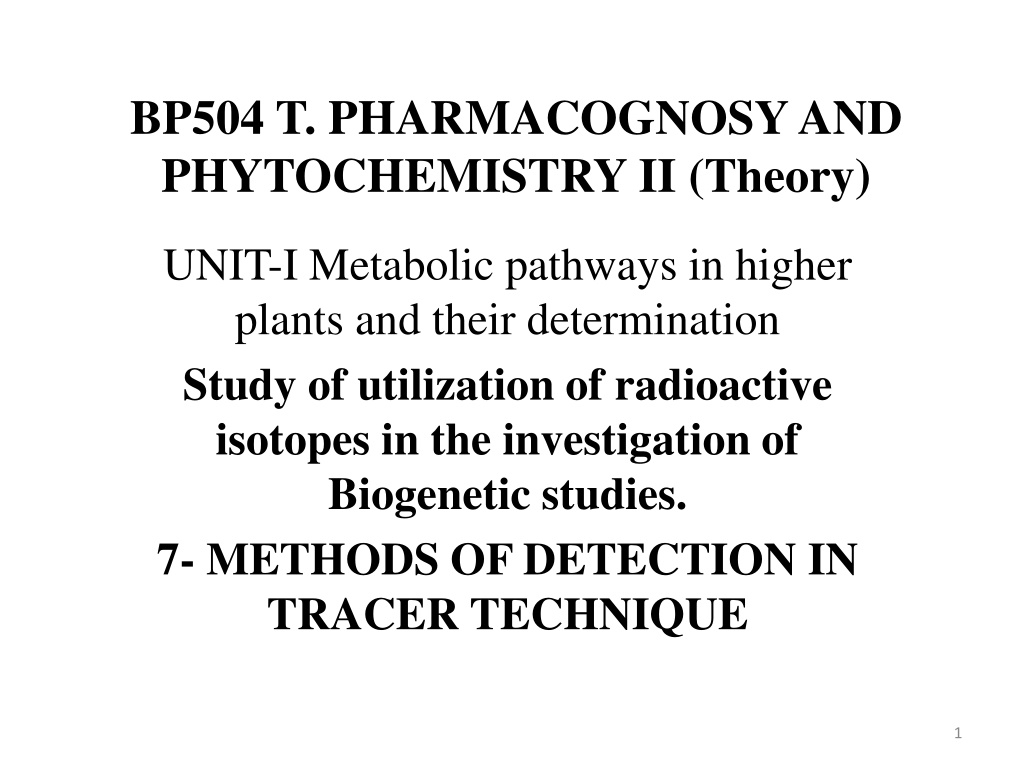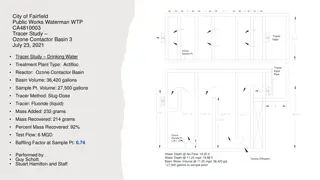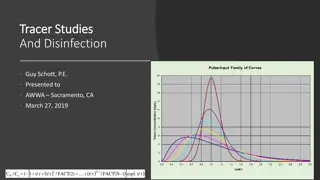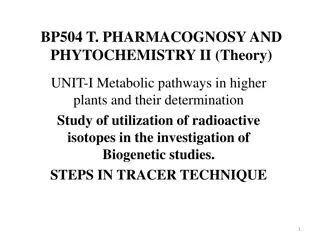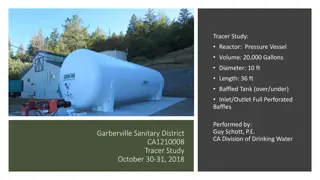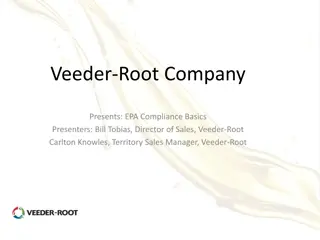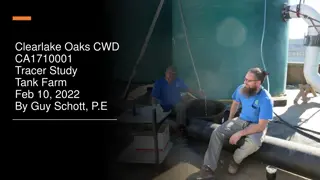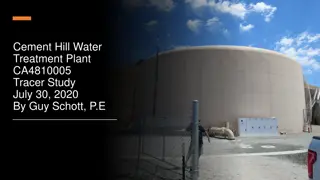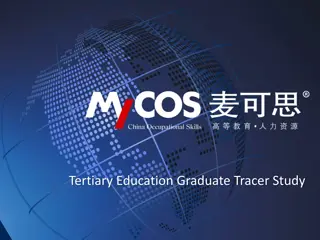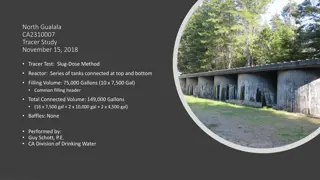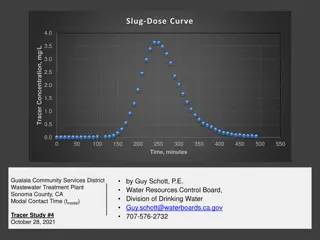Methods of Detection in Tracer Technique for Biogenetic Studies
Explore the methods utilized in tracer techniques for investigating biogenetic pathways in plants. Learn about competitive feeding, precursor-product sequence method, sequential analysis, and isotope incorporation. These methods involve labeling experiments to trace metabolic pathways and understand the biosynthesis of various compounds in plants. Discover how radioactive isotopes are used to determine the precursor involved in the production of specific metabolites and study biogenesis processes in higher plants.
Download Presentation

Please find below an Image/Link to download the presentation.
The content on the website is provided AS IS for your information and personal use only. It may not be sold, licensed, or shared on other websites without obtaining consent from the author. Download presentation by click this link. If you encounter any issues during the download, it is possible that the publisher has removed the file from their server.
E N D
Presentation Transcript
BP504 T. PHARMACOGNOSY AND PHYTOCHEMISTRY II (Theory) UNIT-I Metabolic pathways in higher plants and their determination Study of utilization of radioactive isotopes in the investigation of Biogenetic studies. 7- METHODS OF DETECTION IN TRACER TECHNIQUE 1
Methods in Tracer Technique I. Competitive feeding II. Precursor product sequence method III. Sequential analysis method IV. Isotope incorporation method 2
I. Competitive feeding Determines the actual precursor involved in the biosynthesis of a particular metabolite. Two precursors are then introduced into two separate groups of plants. If the radioactivity is observed in the group receiving precursor B and not in B1 receiving group, then the biosynthetic pathway for particular metabolite follows order. A B C but not A B1 C Precursor B Compound C Compound A Precursor B1 3
I. Competitive feeding Similarly it was considered that 3, 4 dihydroxy phenyl pyruvic acid would also be synthesized through DOPA but by labeling experiments and competitive feeding it is confirmed that tyrosine directly gives 3, 4 dihydroxy phenyl pyruvic acid. 3, 4 dihydroxy phenyl pyruvic acid Norlaudanosoline Tyrosine DOPA 3, 4 dihydroxy phenyl ethyl amine x DOPA 3, 4 dihydroxy phenyl pyruvic acid Tyrosine correct Applications: Used for elucidation of biogenesis of propane alkaloids, biosynthesis of alkaloids like connine, conhydrine (hemlock) can be studied using C14 labelled compounds 4
2. Precursor product sequence method: In this method, the presumed precursor of the constituent under investigation on a labeled form is fed into the plants for suitable time period. Later the constituents produced in plant are isolated and purified and its radioactivity is determined Disadvantages: Sometimes radioactivity of isolated compound alone is not usually sufficient evident that the precursor fed during the studies is a direct precursor. It is due to the fact that the compounds may enter the general biogenetic pathways and get distributed randomly through the array of phytochemical constituents. In such cases further proof can be obtained from studies by incorporating precursors from double and triple labeling experiments. 5
2. Precursor product sequence method: Eg : Anabasine It is an alkaloid obtained from Nicotiana glauca. Precursor - Lysine (which forms piperidine ring), Double labeling Radioactive labeled lysine (labeled with 6C14 and 7N15) at positions 2, 6 respectively was fed to Nicotiana glauca. C2-14C C6-15N Biogenesis resulted in formation of anabasine alkaloid. With the help of radioactivity determination study, it was proved that radioactive N2 and C at 6th and 2nd positions respectively. 6
2. Precursor product sequence method: Suppose in the same experiment when lysine was labeled with radioactive carbon C14 and nitrogen N15 at same position it was proved that only radioactive carbon and non-labeled N2 was involved in the formation of piperidine ring. Applications: Stopping of hordenine production in barley seedlings after 15- 20 days of germination. Applied in study of biosynthesis of morphine and erogot alkaloids. 7
3. Sequential analysis method The principle of this method of investigation is to grow plant in atmosphere of 14CO2 and then analyze the plant metabolites at a given time intervals to obtain the sequence in which various related compounds become labeled. Example: Mentha piperita 14 CO2 for about 5 mins provided the evidence of probable biosynthetic sequences. OH O O Piperitone Menthol Menthone 8
3. Sequential analysis method Applications: 14CO2 and sequential analysis has been very successfully used in elucidation of carbon in photosynthesis. Determination of sequential formation of opium, hemlock and tobacco alkaloids. 9
4. Isotope incorporation: It provides information about position of bond cleavage & their formation during reaction. Ex: Cleavage of glucose-1-phosphotase catalysed by alkaline phosphatase. Reaction occurs with cleavage of either C-O bond/P-O bond. If the reaction is carried in presence of H2O18 enriched H2O, the C-O cleavage path yields glucose containing one atom of 18O. The P-O cleavage is characterized by phosphate containing one atom 18O. 10
4. Isotope incorporation: During experimentation, the label invariably appears in inorganic phosphate identifying the P-O bond as the cleavage. CH2OH CH2OH O O OH + H2O18 OH + H2PO4 - OH PO3H- O HO HO OH OH 11
Detectors for identification & measurement of radio-labelled compound Geiger Muller Counter- detection of all types of particles Anode (+) Free electron Argon gas Metallic cylinder Cathode (-) e- window + , , radiations Ar+ Ionised Ar gas + - High voltage source Amplifier & counter 12
Scintillation counter Means Luminiscence , Scintillator- substance which has property to luminate- ex: ZnS, NaI (Thallium) 13
Autoradiography To visualize the distribution of radio labelled substance in a biological system and to locate it in various parts of plants Photographic film, emulsion AgBr, AgX, Sample- morphological part of plant/ section of part 14
General applications of tracer techniques Study of sequence cyclisation by use of 14C, 3H labeled mevalonic acid. Inter relationship among 4-methyl sterol and 4, 4 dimethyl sterols by use of 14C acetate. Terpenoid biosynthesis by chloroplasts, isolated in organic solvent by use of two 14C mevalonate. Study of formation of scopoletin by use of labeled phenyl alanine. Study of formation of cinnamic acid in pathway of coumarin from labeled coumarin. Origin of carbon and nitrogen atoms of purine ring system by use of 14C or 15N labeled precursor. 16
General applications of tracer techniques By using 45Ca as a tracer it has been found that the uptake of calcium by plants from the soil is nearly the same both for CaO and CaCO3 in acidic soils. By adding ammonium phosphate labeled with 32P of known specific activity thus uptake of phosphorous is followed by measuring the radioactivity as label reaches first the lower parts of the plant then the upper parts, branches, leaves etc. 17
